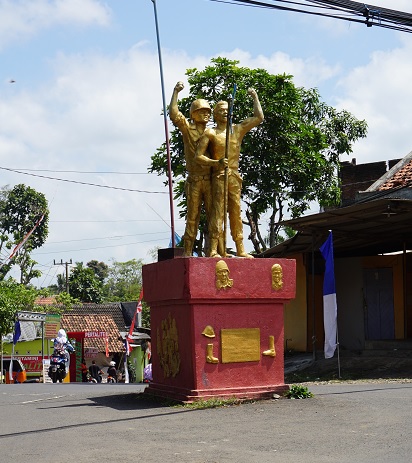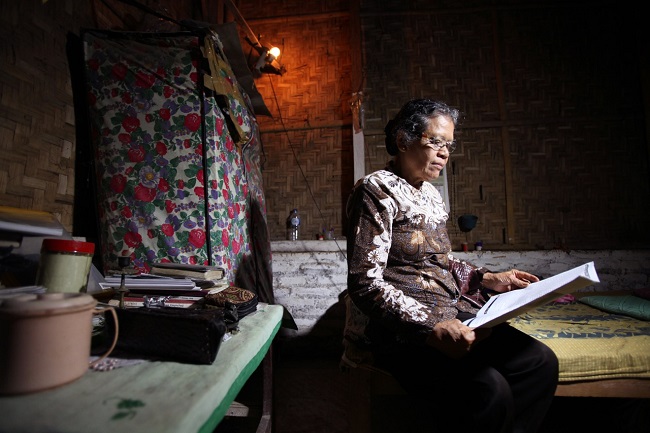1965 collaborators and victims living side by side silently negotiate between past and present
Grace Leksana
As Indonesians are moving further from 1965, scholars and activists are starting to raise awareness about the risk of ‘collective forgetting’: a state-induced situation in which the 1965-66 violence against the Left and communists would be largely forgotten. Whereas in national historiography there is still very little room for articulation of this past, I would argue that in the rural areas where most of the violence occurred, memories of violence remain very much alive today.
These memories persist in the everyday lives of rural communities, despite the state’s structural repression to eliminate them. The memories of violence may not always be apparent in the formal sphere, but they are very present in informal circles, within families, in particular places, and also through silence. In communities where villagers had to continue their daily lives after the violence, silence became a tool for survival as an individual and as members of a community.
However, their silence is not the same as absence, or a negative expression of trauma. On the contrary, it is a navigating device to help them endure their post-violence situation, where the so-called perpetrators and victims live on, side by side. One such place is Donomulyo, East Java, where peasants are battling for agency amid the structural ‘othering’ of accused communists. For them, silence is strategic.
PKI village
Donomulyo district in South Malang is famous for its tourist attractions, such as Ngliyep beach. This area is also well known as a former PKI (Indonesian Communist Party) village. This label not only reflects the intense leftist activity in the 1960s (in the 1955 election, the PKI in Donomulyo garnered 12,981 votes, the best result for the PKI in Malang Regency), but also the extreme violence there during 1965-66 and in the 1968 Trisula operation.
During these anti-communist military operations, villagers were detained and killed, families became separated and their property, including their land, was confiscated. Others were sent to a compulsory reporting and indoctrination program at the local military office for years – a program well-known by villagers as ‘santiaji’. The PKI-affiliated village head in Donomulyo disappeared. He is assumed to have been killed after being detained by the military. One hamlet that I covered in this research was also well-known as the hamlet of widows, because almost all the men disappeared during 1965-66 and 1968.
After those events, village life in Donomulyo (and in many other places in Indonesia) became practically controlled by the military in order to support the authoritarian New Order regime. Village authorities formed new patronage alliances with the military to control most of the agricultural sector in the district, thereby marginalising Donomulyo’s peasants. For villagers in Donomulyo, memories of the violence include its aftermath of major rural transformation during the New Order, including increased military surveillance, diminishing mass cultural and political activities, and exacerbated inequality.
Silence as a survival strategy
I started my fieldwork in Donomulyo in 2016 with the help of my key informant, Suparman (a pseudonym), who was also my landlord during my stay there. Suparman was born in 1945, and pursued his college education in Yogyakarta to become a Catholic catechist. This background, together with the fact that he was one of the descendants of the village pioneers, made him a well-known local leader in the area. His father was one of the founders of the Catholic community in Donomulyo. Suparman himself has taught at Donomulyo’s Catholic school since 1970. He had been actively involved in the Perkumpulan Muda-mudi Katolik Republik Indonesia/ PMKRI (Indonesian Catholic Youth Organisation) since the 1960s, and had intensified these activities during his college education in the cities of Malang and Yogyakarta.

When the 30 September Movement happened, Suparman was in the city of Malang. He told me that the schools were closed and exams were postponed, so he spent those days participating in political activities, as Malang was filled with anti-communist demonstrations. At that time, Suparman was the secretary of the Catholic Party’s branch in Donomulyo. He admitted that his name was used only for formalities, but he learned many things about politics from this organisation.
As an official of the Catholic Party and a PMKRI activist, Suparman joined demonstrations in Malang to demand PKI’s dissolution, walking from Tugu Malang (the city monument) to the main road where the Malang diocese office is located. The Malang bishop then blessed these Catholic demonstrators, and with this blessing, Suparman explained, they felt no fear about joining demonstrations in other areas in East Java and destroying the offices of the PKI and other leftist organisations.
His description of the anti-communist demonstrations in Malang mirrored the nation-wide demonstrations that took place in early to mid-October 1965. These demonstrations were usually organised by the Komando Aksi Pengganyangan Gerakan Tiga Puluh September/ KAP-Gestapu (Action Front to Crush the 30 September Movement), a military-backed coalition of mass organisations. In 1968, together with the Kesatuan Aksi Mahasiswa Indonesia, or KAMI (Indonesian Students Action Front), Suparman was a member of the team screening political prisoners as part of the Trisula operation in Donomulyo. The team’s major task was to select the prisoners that were communists. Those who were considered communists were taken away by a truck and never returned to Donomulyo.
‘A victim of history’
Through Suparman, I was introduced to Marwono (also a pseudonym), a farmer in Donomulyo. Suparman presented Marwono as one of the ex-santiaji, as ‘our brother who became a victim of history’. Marwono, born in 1936 or 1937, had been sent for santiaji in 1968, after being accused of being a member of the BTI, the PKI-affiliated Indonesian Peasants Front. Because of this accusation, village authorities also confiscated his family’s land. During my first visits, Marwono talked openly about the property that his family lost and about the santiaji program, and he repeatedly emphasised that he had no knowledge of BTI activities in the village. And yet I felt that he knew more.
So, after several meetings, I began to reveal my disagreements with the national narrative that blames the PKI. At that point, Marwono began to realise that we were on the ‘same side’ of history. In our next conversation, he told me that although he was not a member of BTI, he knew about their recruitment courses that took place in Donomulyo and, at the time, he had also read books about agrarian reform that he borrowed from his BTI friend. Marwono was also involved in land measurements in his hamlet, as part of the land distribution program prior to the 1965 violence. He expressed his admiration for the PKI village head and contrasted him with the military village head who was assigned to Donomulyo in 1968. It turned out that Marwono knew more than he had admitted in our first meetings. He seemed to nourish his image as a ‘victim of history’, by explaining openly about his santiaji years, while keeping silent about his support for the Left.
On my next visit, while we were talking about trivial things, Marwono suddenly asked, ‘Do you tell my stories to Suparman?’ I was quite surprised, because we were not even talking about Suparman at that time. I only replied, ‘Not all of them’. After a few minutes of silence, I asked him why he asked such a question, but he did not answer and only smiled. I continued by saying, ‘I understand who Suparman is and his position in 1965’. Marwono said, ‘Nah, itu dia (Ah, that’s it)’ and laughed. It was more than enough for me to understand this complex relationship between Marwono and Suparman, and their very different pasts. Suparman, a devoted Catholic and activist in 1960s, was surely anti-communist. Meanwhile, Marwono, an abangan (nominal Muslim) who became Catholic after 1968, was supportive of the BTI and PKI movement. In short, Suparman was a local collaborator with violence, while Marwono was the victim.
Today, Suparman is a highly respected cultural and religious leader, while Marwono is an ordinary farmer with no such status. For Suparman (and perhaps other villagers), Marwono was only a victim of history. But this victim, apparently, knows more and even supported progressive ideas of the Left. Zooming into village life, as illustrated in the case of these two men, silence became an active strategy of survival. The silence in this case, was not a result of direct structural repression by the state, but an active negotiation between past and present, between the individual and the communal.
Sustaining memories of violence
There are other mediums for sustaining memories of violence in rural communities. For example, physical places or sites of memory, which include mass graves, detention centres and, in Donomulyo, a community hall that was built with the contribution of santiajis. These are spaces that contain narratives of violence. These narratives also travel between generations in families (often through different forms of silence) or during communal celebrations, where the older generations meet with the younger ones.
In local schools, history teachers express the challenges of teaching about 1965. Students show a high level of curiosity (also influenced by increasing internet access), asking which version of history is true. In some cases, students also bring their family experience to the class, experiences that were never recorded in history textbooks, such as those of their grandparents who lost lives or property, or stories of mass killings that they heard from elderly villagers.
The experience of Donomulyo shows that the construction of otherness by the state does not necessarily resonate in the same way at the local level. We can see this difference when we look at these villagers as agents of their collective memory and their own history, rather than merely as victims of state repression. Within this perspective, then, silence is an active response to this creation of nationhood that has long excluded a certain group of people.
Grace Leksana (leksana@kitlv.nl) is a PhD candidate at the Royal Netherlands Institute of Southeast Asian and Caribbean Studies (KITLV Leiden) and Leiden Institute of Area Studies (LIAS).












